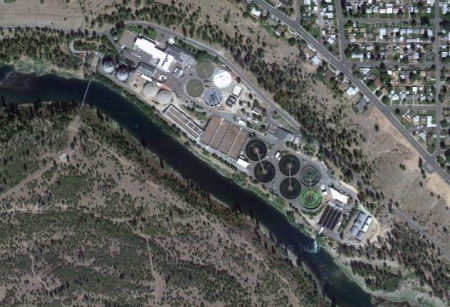Wastewater Treatment
by Andrew Boyd
Today, the unmentionable. The University of Houston's College of Engineering presents this series about the machines that make our civilization run, and the people whose ingenuity created them.
I first ran into it while walking the shoreline of a beautiful deep blue river in the Pacific Northwest. What I saw was big, perhaps the largest I'd ever encountered. Open tanks. Spherical enclosures. It was a modern wastewater treatment plant.


My visceral reaction was "what a shame to be dumping pollutants into such a pristine environment." Then my gut gave way to my head.
Human bodies generate waste. It's simply a fact of life. So one way or another we have to deal with it. And while we turn our noses up at it — both figuratively and literally — it's not life threatening. It is, after all, created by and carried within our bodies.
Liquid waste is especially benign. It's over 95 percent water to begin with, and remaining compounds like sodium and potassium aren't especially frightening. It contains urea, which sounds menacing but really isn't. Urea is colorless, odorless, and non-toxic. Liquid waste is actually sterile in the bladder, though it picks up trace amounts of bacteria as it leaves the body. That's why it's actually used as a disinfectant in some cultures.
Solid waste's a little different. It's still composed of over 75 percent water, and of the remaining 25 percent nothing's especially scary. Unlike liquid waste, however, about 8 percent of solid waste is made up of bacteria, living and dead.
Most bacteria aren't a health threat. In fact, we rely on many different kinds of bacteria to digest our food. But some bacteria have the potential, for a time, to cause trouble when they make their way outside of the intestines. They can cause illness if ingested. Cholera, which can arise in areas where human waste is not properly treated, is an example.
So what exactly do wastewater treatment plants do with the wastewater? The solid and liquid components are separated. The solids are sent to a digester, so-called because special bacteria are introduced to digest the sludge — that's the technical term. The process kills potentially harmful bacteria and creates biogas as a byproduct. The gas can in turn be used to power the plant. What's left of the solids is used for fertilizer or sent to a sanitary landfill.
The vast majority of the waste that arrives at a wastewater treatment plant is liquid; and not just any liquid, but water — with trace amounts of other compounds. Small amounts of chlorine are used to kill whatever bacteria become suspended in the water, after which it's discharged into rivers or oceans. So in the end, wastewater treatment is less about back lot dealings with the unmentionable than it is about simply reclaiming water.
I reminded myself of these facts as I continued my walk downstream of the plant, headed toward one of my favorite river shore parks.

I'm Andy Boyd at the University of Houston, where we're interested in the way inventive minds work.
(Theme music)
Notes and references:
The facility described in the essay is the Riverside Park Water Reclamation Facility serving the city of Spokane, Washington. It is depicted above.
E. Coli. From the US CDC website: https://www.cdc.gov/ecoli/general/. Accessed June 27, 2013.
Feces. From the Encyclopedia Britannica website: https://www.britannica.com/EBchecked/topic/203293/feces. Accessed June 27, 2013.
Urea. From the Wikipedia website: https://en.wikipedia.org/wiki/Urine#Composition. Accessed June 27, 2013.
Urine. From the Wikipedia website: https://en.wikipedia.org/wiki/Urea. Accessed June 27, 2013.
Water: Monitoring and Assessment: Fecal Matter. From the US EPA website: http://water.epa.gov/type/rsl/monitoring/vms511.cfm. Accessed June 27, 2013.
The overhead picture of the Spokane waste treatment facility is from Google Maps. All remaining pictures of the Spokane River near the facility are from Washington State government websites.
This episode first aired on July 11, 2013.